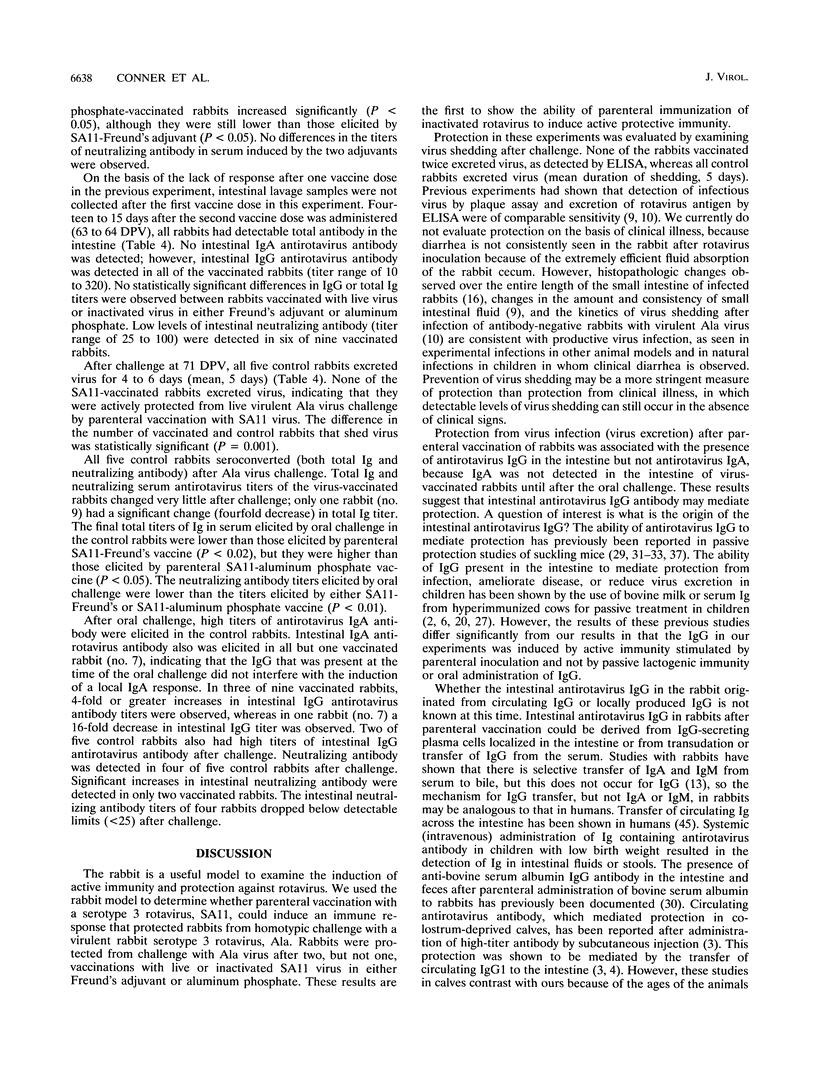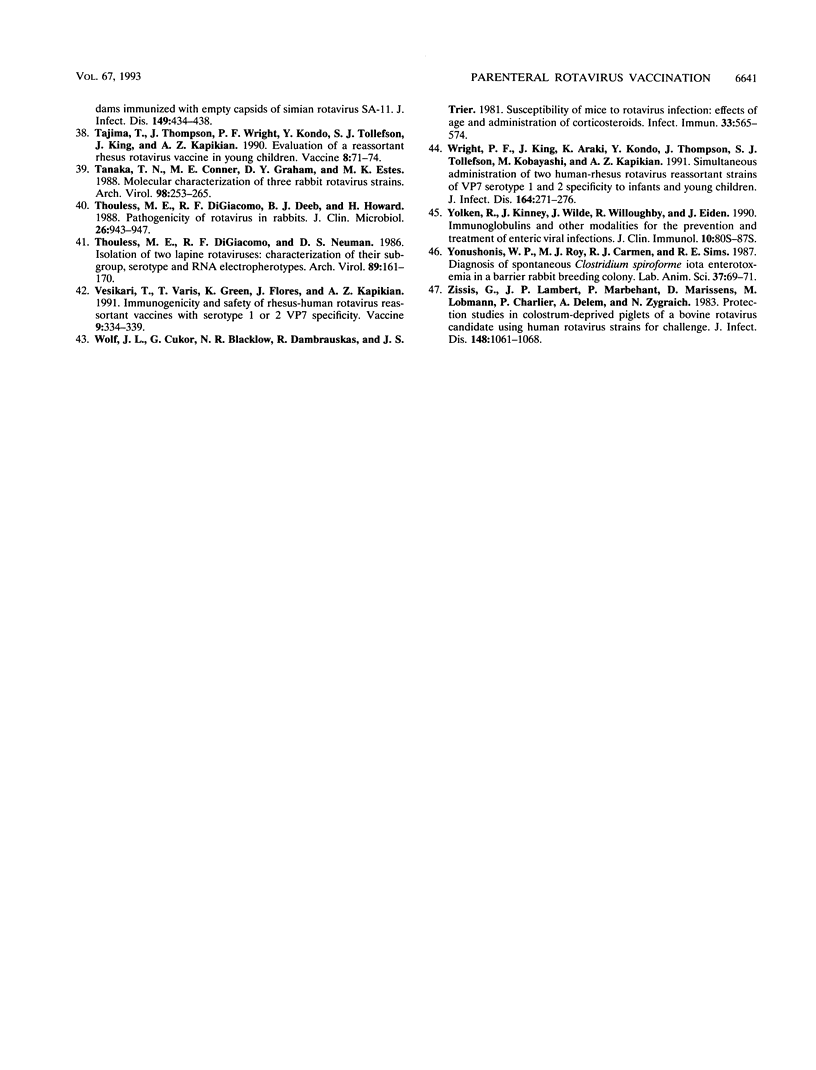Abstract
We performed experiments to determine whether parenteral immunization with SA11 rotavirus can induce active protective immunity in a rabbit model of rotavirus infection. After one or two intramuscular injections of 1 ml of live or formalin-inactivated SA11 virus, we evaluated the mucosal and serologic immune response and protection from challenge with a high dose of live, virulent rabbit (Ala) rotavirus. Inactivated SA11 virus preparations, evaluated by enzyme-linked immunosorbent assay (ELISA) with a panel of VP4- and VP7-specific neutralizing and nonneutralizing monoclonal antibodies, did not show a loss of epitopes from the inactivation procedure compared with live virus. Administration of two doses of vaccine, one at zero days postvaccination (DPV) and a booster shot at 49 DPV, followed by challenge at 71 DPV with 3.5 x 10(5) PFU of Ala virus resulted in protection from challenge. None of the two-dose virus-vaccinated rabbits shed virus after challenge, while virus shedding was detected in all control rabbits (P = 0.001, Fisher's exact two-tailed test). Differences in total serum immunoglobulin (Ig) antirotavirus ELISA titers (P < 0.05, Wilcoxon's rank sum test) were observed between groups vaccinated with virus in aluminum phosphate or Freund's adjuvant but not between groups vaccinated with live or inactivated virus in either adjuvant. All rabbits given two doses of vaccine had detectable antirotavirus intestinal antibody of the IgG, but not IgA, isotype. After challenge, fourfold or greater increases in intestinal IgG antibody responses were observed in three rabbits, whereas all controls and all but one virus-vaccinated rabbit had an intestinal IgA antibody response. In contrast, vaccination of rabbits with one dose of SA11 followed by challenge at 21 DPV did not protect from challenge; no difference in the mean number of days of virus shedding between any of the vaccinated groups and controls was observed. A serologic, but not a mucosal, antibody response was observed after the one-dose vaccination regimen. Differences in serologic antibody titers were not observed between any of the one-dose virus-vaccinated groups. These data indicate that parenteral vaccination with two, but not one, doses of rotavirus in either Freund's adjuvant or aluminum phosphate can induce active protection from challenge.(ABSTRACT TRUNCATED AT 400 WORDS)
Full text
PDF








Selected References
These references are in PubMed. This may not be the complete list of references from this article.
- Barnes G. L., Doyle L. W., Hewson P. H., Knoches A. M., McLellan J. A., Kitchen W. H., Bishop R. F. A randomised trial of oral gammaglobulin in low-birth-weight infants infected with rotavirus. Lancet. 1982 Jun 19;1(8286):1371–1373. doi: 10.1016/s0140-6736(82)92496-5. [DOI] [PubMed] [Google Scholar]
- Besser T. E., Gay C. C., McGuire T. C., Evermann J. F. Passive immunity to bovine rotavirus infection associated with transfer of serum antibody into the intestinal lumen. J Virol. 1988 Jul;62(7):2238–2242. doi: 10.1128/jvi.62.7.2238-2242.1988. [DOI] [PMC free article] [PubMed] [Google Scholar]
- Besser T. E., McGuire T. C., Gay C. C., Pritchett L. C. Transfer of functional immunoglobulin G (IgG) antibody into the gastrointestinal tract accounts for IgG clearance in calves. J Virol. 1988 Jul;62(7):2234–2237. doi: 10.1128/jvi.62.7.2234-2237.1988. [DOI] [PMC free article] [PubMed] [Google Scholar]
- Borriello S. P., Carman R. J. Association of iota-like toxin and Clostridium spiroforme with both spontaneous and antibiotic-associated diarrhea and colitis in rabbits. J Clin Microbiol. 1983 Mar;17(3):414–418. doi: 10.1128/jcm.17.3.414-418.1983. [DOI] [PMC free article] [PubMed] [Google Scholar]
- Brüssow H., Hilpert H., Walther I., Sidoti J., Mietens C., Bachmann P. Bovine milk immunoglobulins for passive immunity to infantile rotavirus gastroenteritis. J Clin Microbiol. 1987 Jun;25(6):982–986. doi: 10.1128/jcm.25.6.982-986.1987. [DOI] [PMC free article] [PubMed] [Google Scholar]
- Cadranel S., Zeglache S., Jonckheer T., Zissis G., Andre F. E., Bogaerts H., Delem A. Factors affecting antibody response of newborns to repeated administrations of the rotavirus vaccine RIT 4237. J Pediatr Gastroenterol Nutr. 1987 Jul-Aug;6(4):525–528. doi: 10.1097/00005176-198707000-00005. [DOI] [PubMed] [Google Scholar]
- Conner M. E., Estes M. K., Graham D. Y. Rabbit model of rotavirus infection. J Virol. 1988 May;62(5):1625–1633. doi: 10.1128/jvi.62.5.1625-1633.1988. [DOI] [PMC free article] [PubMed] [Google Scholar]
- Conner M. E., Gilger M. A., Estes M. K., Graham D. Y. Serologic and mucosal immune response to rotavirus infection in the rabbit model. J Virol. 1991 May;65(5):2562–2571. doi: 10.1128/jvi.65.5.2562-2571.1991. [DOI] [PMC free article] [PubMed] [Google Scholar]
- Delacroix D. L., Denef A. M., Acosta G. A., Montgomery P. C., Vaerman J. P. Immunoglobulins in rabbit hepatic bile: selective secretion of IgA and IgM and active plasma-to-bile transfer of polymeric IgA. Scand J Immunol. 1982 Oct;16(4):343–350. doi: 10.1111/j.1365-3083.1982.tb00733.x. [DOI] [PubMed] [Google Scholar]
- Ericson B. L., Graham D. Y., Mason B. B., Estes M. K. Identification, synthesis, and modifications of simian rotavirus SA11 polypeptides in infected cells. J Virol. 1982 Jun;42(3):825–839. doi: 10.1128/jvi.42.3.825-839.1982. [DOI] [PMC free article] [PubMed] [Google Scholar]
- Flores J., Perez-Schael I., Blanco M., White L., Garcia D., Vilar M., Cunto W., Gonzalez R., Urbina C., Boher J. Comparison of reactogenicity and antigenicity of M37 rotavirus vaccine and rhesus-rotavirus-based quadrivalent vaccine. Lancet. 1990 Aug 11;336(8711):330–334. doi: 10.1016/0140-6736(90)91876-c. [DOI] [PubMed] [Google Scholar]
- Guesdon J. L., Ternynck T., Avrameas S. The use of avidin-biotin interaction in immunoenzymatic techniques. J Histochem Cytochem. 1979 Aug;27(8):1131–1139. doi: 10.1177/27.8.90074. [DOI] [PubMed] [Google Scholar]
- Hambraeus B. A., Hambraeus L. E., Wadell G. Animal model of rotavirus infection in rabbits--protection obtained without shedding of viral antigen. Arch Virol. 1989;107(3-4):237–251. doi: 10.1007/BF01317920. [DOI] [PubMed] [Google Scholar]
- Hilpert H., Brüssow H., Mietens C., Sidoti J., Lerner L., Werchau H. Use of bovine milk concentrate containing antibody to rotavirus to treat rotavirus gastroenteritis in infants. J Infect Dis. 1987 Jul;156(1):158–166. doi: 10.1093/infdis/156.1.158. [DOI] [PubMed] [Google Scholar]
- Ho M. S., Glass R. I., Pinsky P. F., Anderson L. J. Rotavirus as a cause of diarrheal morbidity and mortality in the United States. J Infect Dis. 1988 Nov;158(5):1112–1116. doi: 10.1093/infdis/158.5.1112. [DOI] [PubMed] [Google Scholar]
- Hoshino Y., Wyatt R. G., Greenberg H. B., Flores J., Kapikian A. Z. Serotypic similarity and diversity of rotaviruses of mammalian and avian origin as studied by plaque-reduction neutralization. J Infect Dis. 1984 May;149(5):694–702. doi: 10.1093/infdis/149.5.694. [DOI] [PubMed] [Google Scholar]
- Kapikian A. Z., Flores J., Midthun K., Hoshino Y., Green K. Y., Gorziglia M., Nishikawa K., Chanock R. M., Potash L., Perez-Schael I. Strategies for the development of a rotavirus vaccine against infantile diarrhea with an update on clinical trials of rotavirus vaccines. Adv Exp Med Biol. 1989;257:67–89. doi: 10.1007/978-1-4684-5712-4_9. [DOI] [PubMed] [Google Scholar]
- Koopman J. S., Turkish V. J., Monto A. S., Gouvea V., Srivastava S., Isaacson R. E. Patterns and etiology of diarrhea in three clinical settings. Am J Epidemiol. 1984 Jan;119(1):114–123. doi: 10.1093/oxfordjournals.aje.a113712. [DOI] [PubMed] [Google Scholar]
- LeBaron C. W., Furutan N. P., Lew J. F., Allen J. R., Gouvea V., Moe C., Monroe S. S. Viral agents of gastroenteritis. Public health importance and outbreak management. MMWR Recomm Rep. 1990 Apr 27;39(RR-5):1–24. [PubMed] [Google Scholar]
- Losonsky G. A., Johnson J. P., Winkelstein J. A., Yolken R. H. Oral administration of human serum immunoglobulin in immunodeficient patients with viral gastroenteritis. A pharmacokinetic and functional analysis. J Clin Invest. 1985 Dec;76(6):2362–2367. doi: 10.1172/JCI112248. [DOI] [PMC free article] [PubMed] [Google Scholar]
- Matson D. O., Estes M. K. Impact of rotavirus infection at a large pediatric hospital. J Infect Dis. 1990 Sep;162(3):598–604. doi: 10.1093/infdis/162.3.598. [DOI] [PubMed] [Google Scholar]
- Matsui S. M., Offit P. A., Vo P. T., Mackow E. R., Benfield D. A., Shaw R. D., Padilla-Noriega L., Greenberg H. B. Passive protection against rotavirus-induced diarrhea by monoclonal antibodies to the heterotypic neutralization domain of VP7 and the VP8 fragment of VP4. J Clin Microbiol. 1989 Apr;27(4):780–782. doi: 10.1128/jcm.27.4.780-782.1989. [DOI] [PMC free article] [PubMed] [Google Scholar]
- McCleery J. L., Kraft S. C., Rothberg R. M. Demonstration of antibody in rabbit feces after active or passive parenteral immunization. Digestion. 1970;3(4):213–221. doi: 10.1159/000197034. [DOI] [PubMed] [Google Scholar]
- Offit P. A., Clark H. F. Protection against rotavirus-induced gastroenteritis in a murine model by passively acquired gastrointestinal but not circulating antibodies. J Virol. 1985 Apr;54(1):58–64. doi: 10.1128/jvi.54.1.58-64.1985. [DOI] [PMC free article] [PubMed] [Google Scholar]
- Offit P. A., Dudzik K. I. Noninfectious rotavirus (strain RRV) induces an immune response in mice which protects against rotavirus challenge. J Clin Microbiol. 1989 May;27(5):885–888. doi: 10.1128/jcm.27.5.885-888.1989. [DOI] [PMC free article] [PubMed] [Google Scholar]
- Offit P. A., Shaw R. D., Greenberg H. B. Passive protection against rotavirus-induced diarrhea by monoclonal antibodies to surface proteins vp3 and vp7. J Virol. 1986 May;58(2):700–703. doi: 10.1128/jvi.58.2.700-703.1986. [DOI] [PMC free article] [PubMed] [Google Scholar]
- Perez-Schael I., Blanco M., Vilar M., Garcia D., White L., Gonzalez R., Kapikian A. Z., Flores J. Clinical studies of a quadrivalent rotavirus vaccine in Venezuelan infants. J Clin Microbiol. 1990 Mar;28(3):553–558. doi: 10.1128/jcm.28.3.553-558.1990. [DOI] [PMC free article] [PubMed] [Google Scholar]
- Ramig R. F. The effects of host age, virus dose, and virus strain on heterologous rotavirus infection of suckling mice. Microb Pathog. 1988 Mar;4(3):189–202. doi: 10.1016/0882-4010(88)90069-1. [DOI] [PubMed] [Google Scholar]
- Rodriguez W. J., Kim H. W., Brandt C. D., Schwartz R. H., Gardner M. K., Jeffries B., Parrott R. H., Kaslow R. A., Smith J. I., Kapikian A. Z. Longitudinal study of rotavirus infection and gastroenteritis in families served by a pediatric medical practice: clinical and epidemiologic observations. Pediatr Infect Dis J. 1987 Feb;6(2):170–176. doi: 10.1097/00006454-198702000-00006. [DOI] [PubMed] [Google Scholar]
- Sheridan J. F., Smith C. C., Manak M. M., Aurelian L. Prevention of rotavirus-induced diarrhea in neonatal mice born to dams immunized with empty capsids of simian rotavirus SA-11. J Infect Dis. 1984 Mar;149(3):434–438. doi: 10.1093/infdis/149.3.434. [DOI] [PubMed] [Google Scholar]
- Tajima T., Thompson J., Wright P. F., Kondo Y., Tollefson S. J., King J., Kapikian A. Z. Evaluation of a reassortant rhesus rotavirus vaccine in young children. Vaccine. 1990 Feb;8(1):70–74. doi: 10.1016/0264-410x(90)90181-k. [DOI] [PubMed] [Google Scholar]
- Tanaka T. N., Conner M. E., Graham D. Y., Estes M. K. Molecular characterization of three rabbit rotavirus strains. Arch Virol. 1988;98(3-4):253–265. doi: 10.1007/BF01322173. [DOI] [PubMed] [Google Scholar]
- Thouless M. E., DiGiacomo R. F., Deeb B. J., Howard H. Pathogenicity of rotavirus in rabbits. J Clin Microbiol. 1988 May;26(5):943–947. doi: 10.1128/jcm.26.5.943-947.1988. [DOI] [PMC free article] [PubMed] [Google Scholar]
- Thouless M. E., DiGiacomo R. F., Neuman D. S. Isolation of two lapine rotaviruses: characterization of their subgroup, serotype and RNA electropherotypes. Arch Virol. 1986;89(1-4):161–170. doi: 10.1007/BF01309886. [DOI] [PubMed] [Google Scholar]
- Vesikari T., Varis T., Green K., Flores J., Kapikian A. Z. Immunogenicity and safety of rhesus-human rotavirus reassortant vaccines with serotype 1 or 2 VP7 specificity. Vaccine. 1991 May;9(5):334–339. doi: 10.1016/0264-410x(91)90060-j. [DOI] [PubMed] [Google Scholar]
- Wolf J. L., Cukor G., Blacklow N. R., Dambrauskas R., Trier J. S. Susceptibility of mice to rotavirus infection: effects of age and administration of corticosteroids. Infect Immun. 1981 Aug;33(2):565–574. doi: 10.1128/iai.33.2.565-574.1981. [DOI] [PMC free article] [PubMed] [Google Scholar]
- Wright P. F., King J., Araki K., Kondo Y., Thompson J., Tollefson S. J., Kobayashi M., Kapikian A. Z. Simultaneous administration of two human-rhesus rotavirus reassortant strains of VP7 serotype 1 and 2 specificity to infants and young children. J Infect Dis. 1991 Aug;164(2):271–276. doi: 10.1093/infdis/164.2.271. [DOI] [PubMed] [Google Scholar]
- Yolken R., Kinney J., Wilde J., Willoughby R., Eiden J. Immunoglobulins and other modalities for the prevention and treatment of enteric viral infections. J Clin Immunol. 1990 Nov;10(6 Suppl):80S–87S. doi: 10.1007/BF00918695. [DOI] [PubMed] [Google Scholar]
- Yonushonis W. P., Roy M. J., Carman R. J., Sims R. E. Diagnosis of spontaneous Clostridium spiroforme iota enterotoxemia in a barrier rabbit breeding colony. Lab Anim Sci. 1987 Feb;37(1):69–71. [PubMed] [Google Scholar]
- Zissis G., Lambert J. P., Marbehant P., Marissens D., Lobmann M., Charlier P., Delem A., Zygraich N. Protection studies in colostrum-deprived piglets of a bovine rotavirus vaccine candidate using human rotavirus strains for challenge. J Infect Dis. 1983 Dec;148(6):1061–1068. doi: 10.1093/infdis/148.6.1061. [DOI] [PubMed] [Google Scholar]


